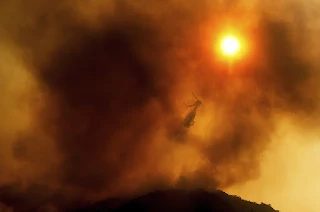Trump seeks to end climate research at premier U.S. climate agency
President Donald Trump’s administration is seeking to end nearly all of the climate research conducted by the U.S. National Oceanic and Atmospheric Agency (NOAA), one of the country’s premier climate science agencies, according to an internal budget document seen by Science. The document indicates the White House is ready to ask Congress to eliminate NOAA’s climate research centers and cut hundreds of federal and academic climate scientists who track and study human-driven global warming.
The administration is also preparing to ask for deep cuts to NASA’s science programs, according to media reports today.
The proposed NOAA cuts—which could be altered before the administration sends its 2026 budget request to Congress in the coming weeks—would cut funding for the agency’s research arm, the Office of Oceanic and Atmospheric Research (OAR), to just over $171 million, a drop of $485 million. Any remaining research funding from previously authorized budgets would be moved to other programs. “At this funding level, OAR is eliminated as a line office,” the document states.
If approved by Congress, the plan would represent a huge blow to efforts to understand climate change, says Craig McLean, OAR’s longtime director who retired in 2022. “It wouldn’t just gut it. It would shut it down.” Scientifically, he adds, obliterating OAR would send the United States back to the 1950s—all because the Trump administration doesn’t like the answers to scientific questions NOAA has been studying for a half-century, according to McLean.
The administration’s plan would “eliminate all funding for climate, weather, and ocean laboratories and cooperative institutes,” says the document, which reflects discussions between NOAA and the White House Office of Management and Budget (OMB) about the agency’s 2026 budget request. Currently, NOAA operates 10 research labs around the country. They include influential ocean research centers in Florida and Washington state; five atmospheric science labs in Boulder, Colorado, and Maryland; and a severe storm lab in Oklahoma. It also operates the Geophysical Fluid Dynamics Laboratory in New Jersey, the birthplace of weather and climate modeling, as well as a lab in Michigan devoted to the Great Lakes. The agency further funds cooperative institutes, which support a large collection of academic scientists who work closely with the NOAA labs.
The proposal would cut NOAA’s competitive climate research grants program, which awards roughly $70 million a year to academic scientists. It would end support for collecting regional climate data and information, often used by farmers and other industries. And it would terminate the agency’s National Oceanographic Partnership Program and college and aquaculture sea grant programs, which support a host of research efforts.
NOAA officials still have time to persuade OMB to alter the request, but NOAA sources said it is unlikely to substantially change. But this proposal is only the first stage of the budget process; Congress will have the final word in setting NOAA’s spending.
It will certainly face strong opposition from Democrats. “Trump’s budget plan for NOAA is both outrageous and dangerous,” said Representative Zoe Lofgren (D–CA), the ranking member of the U.S. House of Representatives’s science committee, in a statement to Science. “This administration’s hostility towards research and rejection of climate science will have the consequence of eviscerating the weather forecasting capabilities that this plan claims to preserve.”
At NASA, science programs also face severe cuts, according to details first reported by Ars Technica. The White House is considering requesting a nearly 50% cut to NASA science’s office, down to an overall budget of $3.9 billion. According to Ars Technica, the plan calls for: “a two-thirds cut to astrophysics, down to $487 million; a greater than two-thirds cut to heliophysics, down to $455 million; a greater than 50 percent cut to Earth science, down to $1.033 billion; and a 30 percent cut to Planetary science, down to $1.929 billion.”
Such NASA cuts would require ending the operations of a huge host of earth science satellites. They could also result in the closure of NASA’s Goddard Space Flight Center in Maryland, which has thousands of employees and is one of the agency’s premier centers for earth science research. The cuts would also end plans for Mars Sample Return, the DAVINCI mission to Venus, and the Nancy Grace Roman Space Telescope, which is almost fully assembled.
At NOAA, the agency’s budget would be cut by $1.7 billion, the OMB memo said. The proposal also seeks to cut the National Ocean Service in half, with “no funding for Integrated Ocean Observing System Regional Observations, Competitive Research, Coastal Zone Management Grants, National Coastal Resilience Fund, or the National Estuarine Research Reserve System.” The requests would also close the National Centers for Coastal Ocean Science.
Other NOAA divisions would also be hit. OMB is seeking to radically rework the next-generation geostationary weather satellites planned by the agency’s National Environmental Satellite, Data, and Information Service (NESDIS). That includes cutting its planned atmospheric pollution and ocean color instruments because, as the document puts it, the satellites will deliver exclusively “weather” data. It could also cut the infrared sounder, which tracks changes in the vertical distribution of temperature and moistures, catching storms before they form, and a lightning mapper.
The request would also cut funding for the National Center for Environmental Information—the nation’s primary archive of climate data—by $18 million. And it trims mission support for NOAA’s satellites and data systems by $141 million, among many other proposals.
Though Republicans in the U.S. Congress have so far not shown much resistance to the administration, McLean expressed some hope that lawmakers will not approve these cuts, citing how much of NOAA spending is spread throughout their districts. But that’s not a sure thing, he says. “It’s a very different Congress today.”

댓글
댓글 쓰기